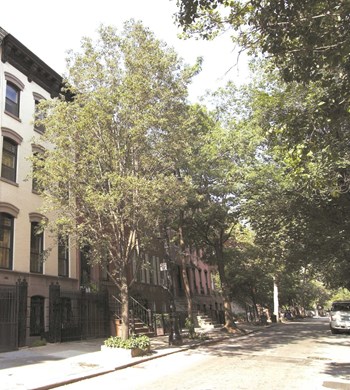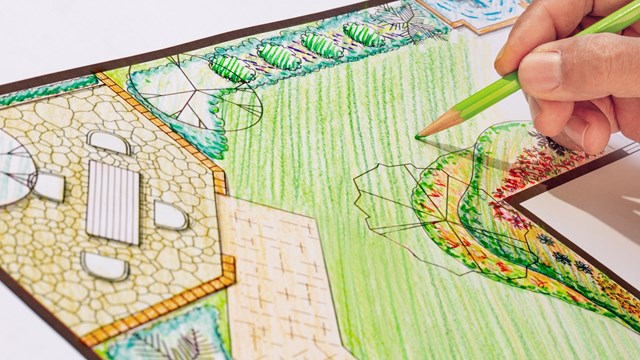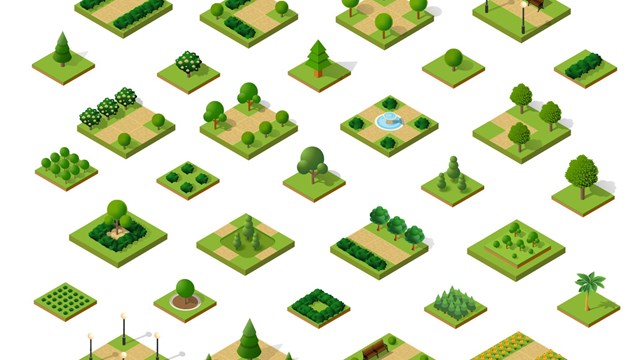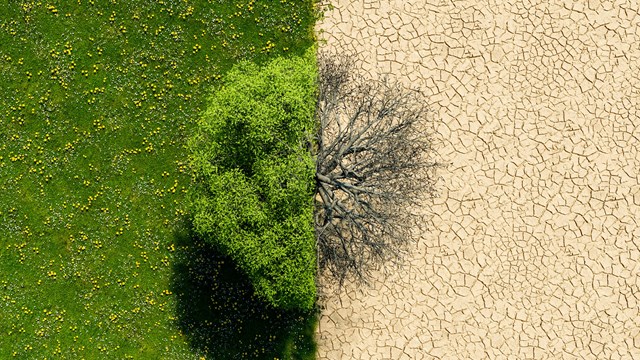
They are the greenery that gives life to our cities, the leafy giants that give us shade and that unforgettable rustling sound just outside our windows late at night. Trees are the unsung heroes of the urban landscape—and with proper planning and care, they can add immeasurably to the livability and character of a co-op or condominium community.
The Right Tree, in the Right Spot
For a tree to thrive it needs to be the right tree in the right spot and it needs to be cared for properly. Several factors should be considered when selecting a tree for a particular location or purpose.
“There are lots of different kinds of trees and lots of different considerations” that go into making these choices, says Michael Galvin, director of the consulting group for SavATree. “The urban environment is not a native environment to planet Earth. We like to promote native trees, but some native trees won’t do well in that environment.”
With that in mind, “Urban-tolerant trees are those best suited for city environments,” says Ken Almstead, CEO of Almstead Tree & Shrub Care, based in New Rochelle. “Typically these species can tolerate heat, drought, smaller soil volume, pollution and other city stresses. And, although every site is different, some of the species that have passed the test of time include London plane, sycamore, various elm species, Japanese zelkova, linden, ginkgo, and katsura, which are larger size trees.”
More medium size trees include Scholar, Hornbeam, Goldenraintree, says Almstead, with Hawthorn and Japanese flowering cherry trees on the smaller end of the spectrum.
The New York City Parks Department has a list of urban-tolerant trees. The list “provides further information and is good for associations to know if deciding to file for a permit for a tree replacement,” says Almstead.
Sometimes the question of which tree to plant can come down to deciding between native and non-native trees. “Native trees are usually the best adapted to an area’s climate and weather,” says Sam Bishop, director of education for Trees New York. “But, non-native trees can have fewer problems with pests and diseases. That said, non-native trees usually have other problems, and are not very useful for local wildlife.”
Perhaps the most important factor is to “match the tree’s needs to the site,” says Bishop.
Almstead agrees. “You need the right tree for the right location,” he says. “The wrong species in the wrong spot can cause issues with clearance, interference with structures and just simply be inappropriate for the site and location.”
The tree itself may suffer as well. “The life and maturity is greatly diminished,” Almstead says. “The life span of a New York City street tree is about 10 to 20 years. They have now tried to improve the size of the planting pits, which increases soil volume and has a direct relation to tree maturity. Mostly trees become root-bound in this area as the soil volume can no longer support the root mass.”
Ensuring enough sunlight can be vital to a tree’s survival as well. “For example, most conifers need lots of sun, and planting them in a shady backyard results in poor growing and thin, unattractive trees.”
Galvin agrees, indicating that the scale of the buildings and their relationship to the trees can dictate how much light the tree gets. And that’s a very important variable in the health of the tree. “With ornamental trees, for example, the amount of flowering will be dependent on light,” he says. “You want their crowns to get that sun every day so you get the look you want from the trees.”
If the trees are contributing to a certain look or feel for the landscape and building or community as a whole, it also pays to think ahead—sometimes three or four decades ahead. “Some trees only have a service life of 15 to 40 years,” says Galvin. “For others it’s 70 to 100 years.” Those trees—larger, shade threes like oaks, elms and maples—are likely to be around when the effects of climate change and temperature change are more deeply felt, meaning there may be different threats to their well-being.
Too Close for Comfort
A significant problem with not thinking through a tree plan arises when those trees are planted too close to a building or pathway. “There are many problems if trees are planted [too close] to buildings),” says Galvin. These include heaving and infrastructure damage.
Other problems include obstructed fire escapes and tree branches hitting or blocking windows, says Bishop. In addition, “before planting the tree, get a utilities mark-out so you don’t plant over or close to utilities that may need to be excavated later,” he says. “Planting too close to paving, or paving over a trees roots, is another problem. Both can result in root damage, which injures the tree and could make it more likely to blow over in a storm. For smaller spaces and properties, trees with branches that cross or shade over property lines can be a problem too.”
Sometimes when the tree is first planted, it can be difficult to envision these types of problems ever arising. “Trees start out little and cute and then get big and expensive and if you don’t take care of them, you’ll get problems,” Galvin says. “Think about their eventual size. It may feel funny to plant a small tree 20 to 30 feet away from a building, but it will grow to fill that space.”
Adds Bishop, “It is always hard to imagine what things look like fully grown when they are little trees at the nursery. If at all possible, go to a botanic garden or park and try to see what size the trees will be at 30 or 40 years old before any planting decisions are made.
As landscape architects or landscape committees consider the design of their tree plans, it helps to consider things like lights and the purpose of those lights. “If they’re there to illuminate a public space at night, you’ll want the trees to conflict with them as little as possible,” says Galvin.
In addition, proper tree design can benefit the building’s budgetary bottom line by improving energy efficiency. The idea is to plant for “shade in the summer for less heat and dropped leaves in the winter for more sunlight,” says Galvin.
Fixing Problems
If mistakes were made in the past and the wrong trees were planted in the wrong spaces, there are options, some of them more palatable than others. “You can remove the tree or treat the tree by pruning to reduce the crown,” Galvin says. “You also can root prune the tree,” which can be used to deal with pavement and walkway issues.
Bishop also agrees with moving the tree as a possible solution if it has grown too close to a building or other structure. However, “If it is too large to move, a pruning technique called 'pollarding' may be possible, depending on what kind of tree it is,” he says. “Pollarded trees can look strange when the leaves are off, and pollarding requires pruning every 1-2 years, so it is not always an option.”
Almstead suggests another potential method of mitigation. “Sometimes, for certain species, tree growth regulators can be utilized,” he says. “This will reduce the terminal branch growth, which in turn will reduce the pruning cycle.”
For trees planted too close to paving, Bishop says, “consider changing the paving design to move the paving further away from the tree. Ramping the paving over the tree’s roots is another option, and there are also flexible rubber pavers on the market that bend rather than break.”
Keeping Your Trees Healthy
If all of a building’s trees are planted exactly where they should be and no problems exist with overgrowth, then the goal shifts to keeping those trees healthy and around for as many years as possible.
One risk that almost all trees face is that of pest infestation. Some trees have a better shot at resistance than others, says Almstead. “Zelkova and hornbeam are fairly pest resistant, while Ginkgo trees have no biological pests.”
Bishop adds that one benefit of non-native trees is that “the local pests and diseases do not recognize or want to attack the non-native tree.”
Currently, one particular pest is growing and threatening to overtake a whole species of tree. The Emerald Ash Borer originated in China and has spread to the eastern United States by way of Detroit, where the infestation has decimated the state’s ash tree population. “Unless the trees are treated, they’re goners,” says Galvin. “It can be expensive to treat all the ash trees. Instead, focus on trees with good service life.”
The Asian Longhorned Beetle was another powerful threat to trees in New York. It has, however, “temporarily been eradicated from Manhattan but there are still quarantine areas in Queens and Brooklyn, and recently a new outbreak was detected in Nassau County,” says Almstead.
When it comes to infestations, “there is a wide variety of common pest such as mites, caterpillars, aphids, scale and various fungus and diseases,” says Almstead. “Treatment of these pests depends upon acceptable thresholds that warrant treatment from a health viewpoint as well as an aesthetic one. Timing is very important and every situation can be different so it is best to get some expert advice.”
The application and use of pesticides has advanced in recent years, says Galvin. “In the old days, these treatments were once a year, broad-brush, kill everything approaches.” Today, a particular pest and the tree it is impacting can be examined and studied so that the treatment is applied in optimal amounts and at optimal times, eradicating only the targeted pest and sparing other, helpful species.
Pruning also will go a long way toward keeping a tree healthy. “Pruning is a good practice provided it is done well,” says Bishop. “Younger trees may need to be pruned every year or two to ensure that they develop a strong structure. For older, larger trees, most of the pruning would probably be getting rid of dead wood, unless there is a reason to do something more to the tree.”
Moisture is also a must. “In the Northeast, we typically receive three inches of rainfall in a typical month—and most trees need 4 inches, so we are only supplementing an inch in general.,” says Almstead. “Urban heat stress and drought situations can increase the need for moisture, and in certain situations, irrigation may need to be increased. Providing longer periods of water less frequently is always better than constant irrigation for a healthier and deeper root system.”
Galvin suggests proper mulching as well to support that irrigation. “Make sure there’s mulch around the trees,” he says. “Mulch can retain up to 200 times its weight in moisture.” Keeping a mulch ring around the tree also will help keep turf away, ensuring that the lawn does not compete with the tree for water and nutrients.
With the right amount of planning and dedication to long-term health and well-being, trees are an indispensible and yes, gorgeous, addition to any urban landscape—and well worth all of the effort when those blooms fill the skyline.
Elizabeth Lent is a freelance writer and frequent contributor to The Cooperator.






Leave a Comment